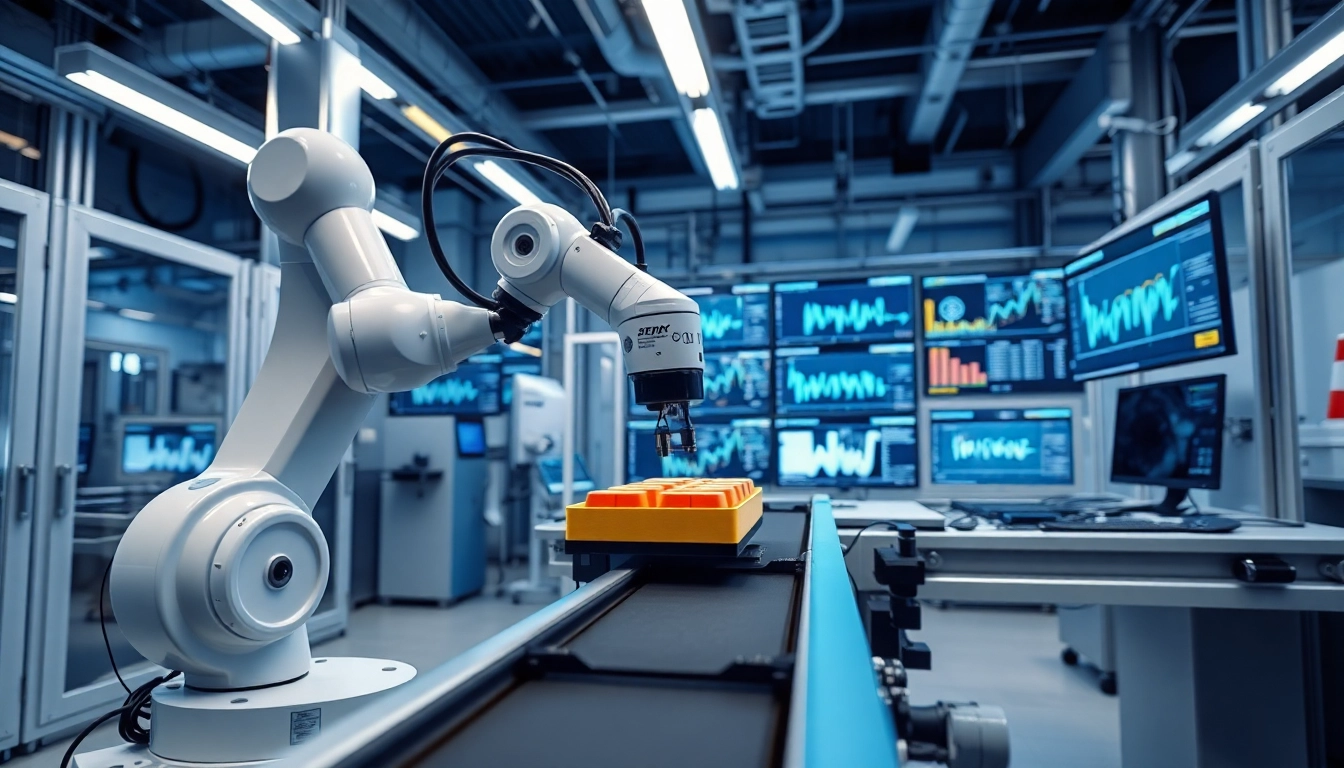
What is Machine Vision?
Machine vision is a revolutionary technology that empowers machines to interpret visual data, akin to how humans perceive the world around them. Leveraging advanced imaging methods, machine vision systems convert visual information into actionable data, enabling automation in various industrial settings. These systems find applications in quality control, robotic guidance, and even in autonomous vehicles, where swift and accurate image processing is crucial. For a detailed exploration of how this technology influences modern industries, you can discover more about machine vision.
Definition and Components of Machine Vision
Machine vision encompasses hardware and software that enable machines to capture, process, and interpret visual information. The core components include:
- Cameras: Capture images or videos of the environment.
- Lighting: Enhances image quality by providing necessary illumination.
- Processing Unit: Analyzes captured data using algorithms.
- Software: Implements machine learning and computer vision techniques for analysis and decision-making.
This combination allows machine vision systems to perform complex tasks such as defect detection, object recognition, and more, streamlining processes that were once manual and labor-intensive.
How Machine Vision Works
The functioning of a machine vision system involves several steps:
- Image Acquisition: Cameras capture images of the target objects under controlled lighting conditions.
- Image Processing: The captured data is converted from analog to digital format and processed. This involves correcting image distortions and enhancing features relevant to the task at hand.
- Analysis: Advanced algorithms analyze the processed images for specific patterns, dimensions, and defects. This yet involves comparing the captured images against predefined criteria.
- Decision Making: Based on the analysis, the system decides whether an object meets quality standards, instructs robots on the next step, or triggers alerts for operators.
Through this sophisticated workflow, machine vision systems contribute significantly to productivity and quality assurance in various sectors.
Applications Across Industries
Machine vision has a wide range of applications across multiple industries:
- Manufacturing: Automated inspection for flaw detection, ensuring product quality.
- Logistics: Scanning barcodes and managing inventory efficiently.
- Healthcare: Analyzing medical images for diagnostics.
- Food and Beverage: Monitoring packaging integrity and product quality.
- Automotive: Guiding assembly robots and inspecting parts for defects.
These applications highlight how integral machine vision technology has become in modernizing workflows and improving accuracy across various sectors.
Key Technologies Behind Machine Vision
Types of Cameras Used in Machine Vision
The choice of camera significantly impacts a machine vision system’s effectiveness. Various camera types include:
- Standard Cameras: These are used for general image capturing and are widely applicable.
- Line Scan Cameras: Ideal for inspecting long and continuous objects, they capture images line by line.
- Area Scan Cameras: These capture images in a two-dimensional matrix, suitable for stationary objects.
- Thermal Cameras: Designed for detecting temperature differences, these are used in safety and maintenance applications.
Selecting the appropriate camera based on the specific application requirements is crucial for optimal results.
Processing Algorithms and Software
Data analysis in machine vision relies on sophisticated algorithms. Common types of processing techniques include:
- Image Segmentation: Dividing images into relevant sections for easier analysis.
- Pattern Recognition: Identifying patterns or features within images using machine learning algorithms.
- Optical Character Recognition (OCR): Translating images of text into machine-encoded text.
- 3D Vision: Creating three-dimensional representations of objects for precise measurements and inspections.
These algorithms, when combined with robust software, represent the backbone of machine vision analysis.
Integration with Robotics and Automation
Machine vision technologies are integral to robotic systems, enhancing their capabilities. Integration involves:
- Guidance Systems: Robots utilize machine vision for navigation and executing precise movements.
- Quality Control: Robots can assess their work, ensuring compliance with set standards.
- Interaction with Humans: Some systems use vision to interpret human actions for collaborative tasks.
This integration leads to improved efficiency, reduced error rates, and increased safety in operations.
Machine Vision vs. Computer Vision
Key Differences Explained
While machine vision and computer vision share similarities, they serve distinct purposes:
- Machine Vision: Focused on automating image-based processes to enhance industrial tasks.
- Computer Vision: A broader field that encompasses various applications, including facial recognition, augmented reality, and scene understanding.
Understanding these differences allows organizations to choose the right technology based on their specific needs.
Use Cases for Each Technology
Machine vision is primarily applied in industrial settings for tasks such as:
- Quality inspection of manufactured goods.
- Barcode reading in logistics.
- Counting and sorting in packaging lines.
Meanwhile, computer vision applications are evolving in areas such as:
- Self-driving vehicles.
- Healthcare diagnostics through image analysis.
- Interactive gaming and augmented reality.
This distinction illustrates how different needs drive the evolution of both technologies.
Choosing the Right Solution for Your Needs
When deciding between machine vision and computer vision, organizations should consider:
- The specific goals and desired outcomes.
- The nature of the tasks and data involved.
- Resource availability for implementation and maintenance.
By performing a thorough analysis of these factors, organizations can better align their technology choice with operational requirements.
Best Practices for Implementing Machine Vision Systems
Assessing Your Needs and Objectives
Before implementing a machine vision system, it is essential to conduct a comprehensive assessment:
- Identify specific tasks that need automation.
- Evaluate the existing processes and areas for improvement.
- Define clear objectives for the machine vision system.
A well-prepared plan lays the foundation for successful deployment and integration.
Installation and Calibration Tips
Successful installation involves a detailed approach to system setup, including:
- Proper positioning of cameras to optimize image capture.
- Setting up compatible lighting to enhance image quality.
- Calibrating the system for precise measurements and evaluations.
Following these tips ensures that the system operates at peak efficiency from the start.
Maintaining and Upgrading Your System
Regular maintenance is vital for the longevity of machine vision systems. This includes:
- Routine cleaning of cameras and optics to prevent distortion.
- Software updates to leverage the latest advancements and security patches.
- Periodic calibration checks to ensure ongoing accuracy.
Proactively upgrading and maintaining the system maximizes performance and minimizes downtime.
Future Trends in Machine Vision Technology
Impact of AI and Machine Learning
The integration of AI and machine learning into machine vision is driving revolutionary changes. These technologies allow systems to:
- Adapt and learn from new data over time, improving accuracy.
- Perform predictive maintenance by analyzing patterns and preventing equipment failures.
- Enhance decision-making processes with data-derived insights.
As AI continues to evolve, we can expect even more significant enhancements in machine vision capabilities.
Emerging Applications and Innovations
Machine vision is continually expanding into new realms, such as:
- Augmented reality applications that overlay digital information onto the real world.
- Advanced robotics that rely on vision systems for autonomous navigation and interaction.
- Smart manufacturing solutions integrating IoT with vision technologies for real-time data analysis.
These innovations promise to enhance operational efficiency and create new opportunities for industries worldwide.
Challenges and Considerations for the Future
Despite the advances in machine vision, several challenges remain:
- Data privacy concerns regarding the use of imaging technologies in public settings.
- The complexity of integrating multiple hardware and software components.
- Addressing the skills gap in technical expertise needed for system operation and troubleshooting.
Overcoming these challenges will be crucial for the widespread adoption and success of machine vision technologies.







